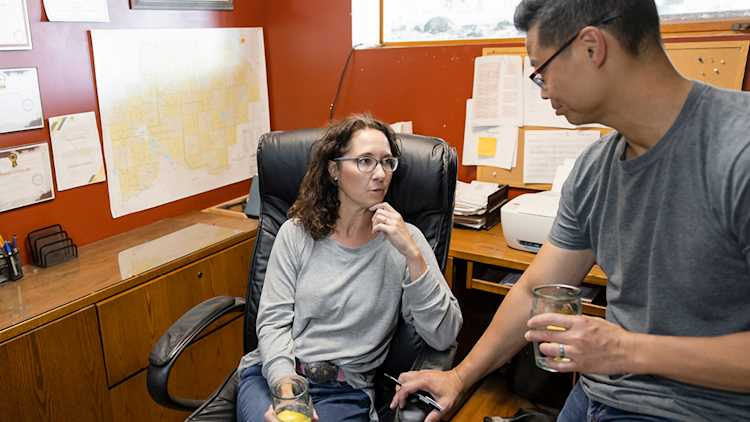Is healthy conflict possible?

In even the most amicable and positive workplaces, team members may occasionally experience conflict. It’s human nature – differences of opinion can pop up. Depending on how it’s handled, the outcome can be extremely positive and talking it out can lead to improved processes or perspectives on a problem. Or it can result in ongoing and festering negativity within the team.
Bonnie Taylor, a psychotherapist and registered social worker based in rural southwestern Ontario, works with farmers to address mental health issues. She knows that conflict management is one area that can challenge farm operations, especially when family members are involved.
Not all conflict is negative.
The first step for farm managers and leaders, according to Taylor, is to understand that a big part of conflict resolution is recognizing that everyone has a different communication style. “Not all conflict is negative,” Taylor says. “Avoiding conflict at all costs means missing opportunities to try new things and benefit from other perspectives or opinions.”
Some people will do almost anything to avoid confrontation or disagreement. Others run towards it at full speed, eager to engage. “Leaders need to reflect on their own management style, including how they present themselves and keep emotions in check when dealing with a disagreement,” Taylor says.
Whether a team leader or employee, one can fall into patterns of communication that make it hard to resolve disagreements. On multi-generational farms, the older generation is often seen as the established leader and has been for a long time. Communication styles can default to stating how things are going to be – end of the story. “This can silence younger family members and employees who find it hard to speak up if they feel like they are not going to be heard or acknowledged,” Taylor says.
Effective leadership involves stepping back and asking: “Have I encouraged everyone to share their thoughts on this topic? Does everyone on the team feel their voice is important in working through this discussion?”
If team members on the farm experience a negative or dismissive reaction from their manager when raising an issue, they may come to assume or predict that will be the response every time. Instead of airing their problem, it could remain unresolved, impacting team morale and performance.
Pause before you react
Taylor uses the simple acronym ‘STOP’ to help farm managers react to conflict in a measured and consistent manner.
S – Stop. If facing a conflict with an employee or between other team members, the first step is to take a moment and listen.
T – Take a breath. Think before responding.
O – Observe. Be aware of your facial expression, body language and emotions. Ask: “Am I being dismissive or negative?”
P – Plan. Follow a consistent approach to set up a private conversation or meeting at an appropriate time and place to talk through ideas or concerns.
Be an effective facilitator
Managers often facilitate conflict resolution between other team members, which can be challenging if family and non-family members are involved. “In this scenario, farm managers must be very aware of remaining neutral. If there is even the perception of favouritism towards an individual or family member, it can severely impact the resolution process and how the team views leadership.”
A good facilitator knows what’s going on between the individuals at odds with each other, helps to determine the root cause of the problem and engages with the participants to find a way forward. Resolution doesn’t always mean finding agreement. It’s about advancing in a way that allows the individuals and the team to work effectively and positively.
“Sometimes a conflict between employees is a personality clash, such as one person on a harvesting crew feeling that a co-worker is not pulling their weight when the pressure is on, which is impacting other team members,” Taylor says. “When these kinds of conflicts aren’t addressed, team members may default to teasing or making snide jokes that create tension. Over time, this can create a toxic work environment. Ideally, the manager would approach both parties individually and ask what’s going on before it takes hold.”
Have a protocol in place
Have a defined protocol in place to create consistency in dealing with disagreements or conflicts. “Post something simple in the shop or barn office to make it clear what the process is if an employee is facing a conflict or has something to get off their chest,” Taylor says. “Explain the steps to new employees and remind everyone of the plan regularly to help ingrain the process into the culture. Most importantly, be sure to reinforce that you invite everyone to air their ideas and concerns by speaking to the appropriate person or by writing it out and sharing it via a comments box.”
Assess outcomes
Having everyone agree and become best friends is not a realistic outcome for conflict management. For example, a successful outcome could be to have two employees say their piece and determine that in the future, they’ll not work together on equipment maintenance tasks that led to the ongoing problems. When conflict becomes deeply entrenched, especially between family members, an external mediator can be invaluable in bringing a completely neutral perspective to the table.
Ultimately, a successful conflict resolution process is one where everyone understands how it works and is comfortable being open about interpersonal problems they’re experiencing at work. For farm families, being able to separate business disagreements from family relationships can be the biggest benefit of all.
From an AgriSuccess article by Peter Gredig.

As someone born with no arms or legs, Chris Koch encourages others to live life to the fullest. From his origins in a small farming community, Chris has travelled the world inspiring others.
